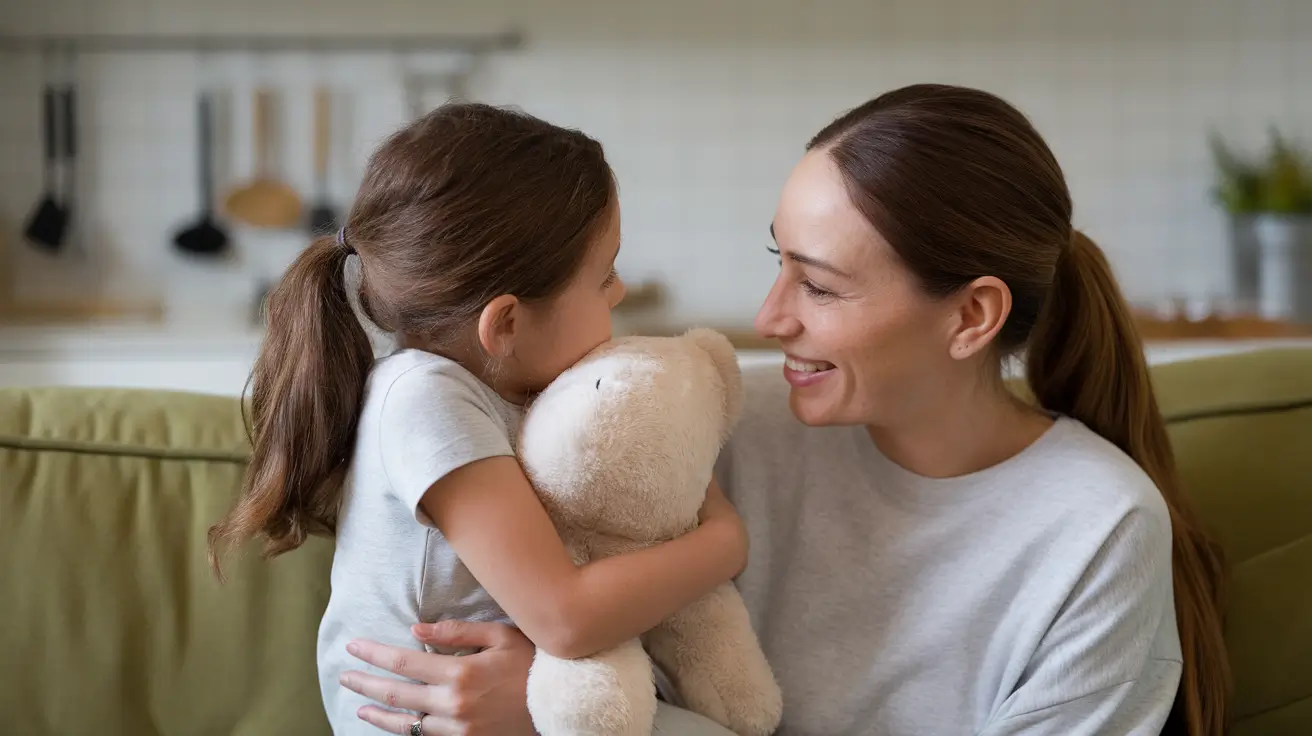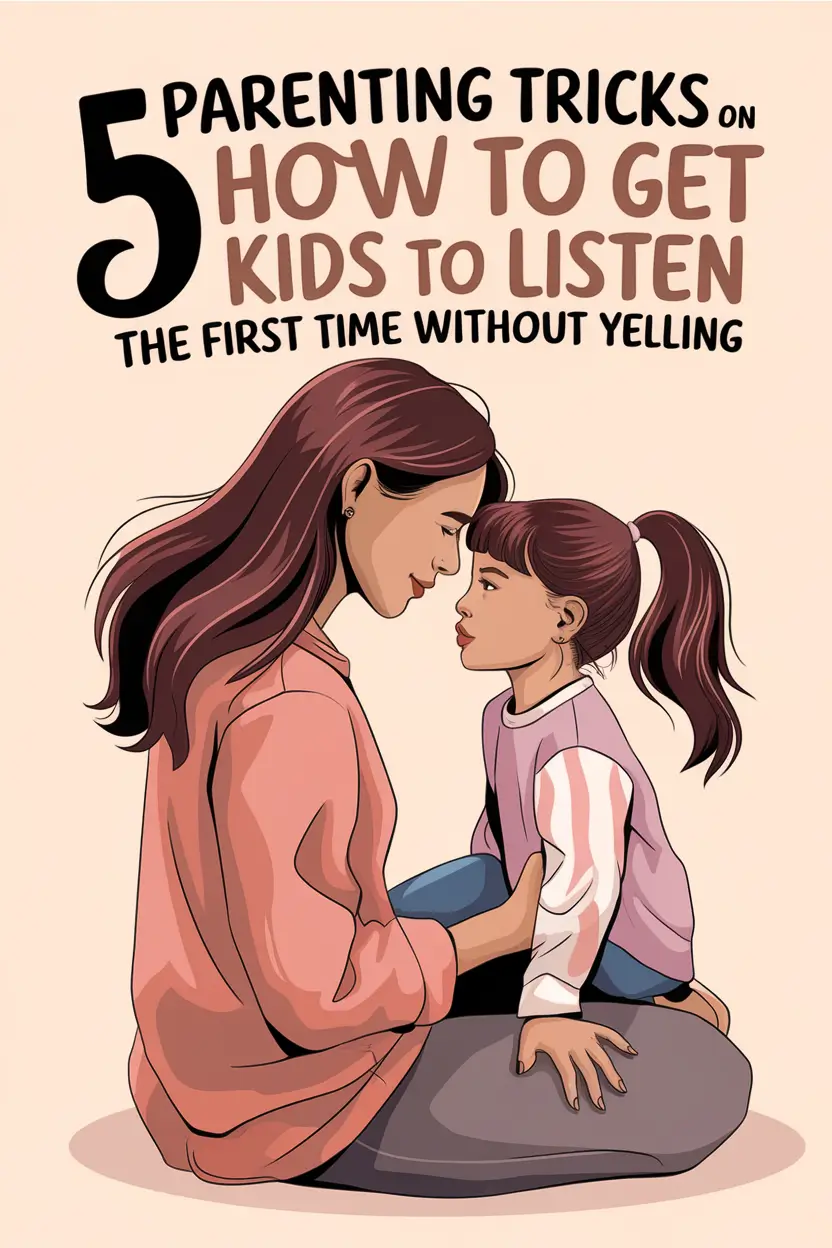Wondering how to get your kids to listen the first time is perhaps one of the most common parental dilemmas we face today. Surprisingly, the solution lies not in your children’s ability to hear, but in your approach to communication. Here’s the game-changing revelation – effective listening starts with transforming how YOU communicate, embracing positive language patterns, and demonstrating the listening skills you wish to see.

How to get your kids to listen the first time
First — Listen to them
Calling out to your children repeatedly can feel like shouting into the void, leaving you questioning whether their hearing needs checking. But before scheduling that audiologist appointment, let’s explore what’s really happening.
Many of us fall into the trap of escalating our volume, hoping that somehow speaking louder will magically improve comprehension. We find ourselves stuck in an endless loop of repetition, sometimes saying the same thing ten times before getting any response. As this negative pattern continues, both parent and child become increasingly frustrated, creating a cycle of miscommunication that seems impossible to break.
True listening encompasses more than just grabbing attention – it’s about ensuring your message resonates deeply enough for your child to act upon it. When your little one responds with resistance or disregards your words entirely, it’s time to shift your perspective and approach.
Consider this real-world scenario: You’re trying to get your child ready for school. Despite multiple reminders, they seem glued to their morning cartoons. Your voice rises with each request, their defiance grows stronger, and suddenly your peaceful morning transforms into a battlefield of wills. But here’s the twist – the problem might not be their listening skills, but rather the timing and method of your communication.
Children process information differently than adults. Their developing minds require specific conditions to effectively absorb and act upon instructions. When they appear to be ignoring you, they might actually be overwhelmed by competing stimuli or simply unable to shift their attention effectively.
Instead of viewing their lack of response as defiance, think of it as an opportunity to fine-tune your communication strategy. Remember, the goal isn’t just to make them hear your words – it’s to help them understand, process, and act upon your guidance willingly and respectfully.
How to Raise Good Listeners
State commands instead of asking questions
Let’s shatter a common misconception right now – your child’s listening abilities aren’t solely determined by their age or temperament. While these factors play a role, the foundation of good listening habits starts with your patience and understanding of your child’s unique personality.
Before diving into quick-fix solutions, take a moment for self-reflection. Consider this thought-provoking truth: your child’s behavior often mirrors your parenting approach. Ask yourself some crucial questions: Are you providing enough emotional warmth? Does your child feel truly understood during conversations? Do they receive adequate recognition for their efforts? Most importantly, do your interactions lean more toward criticism than encouragement?
Building strong listening skills requires a delicate balance of patience (which admittedly, none of us perfectly maintain) and a genuine commitment to understanding your child’s individual nature. This understanding forms the bedrock of all future communication success.
Direct Command vs a Question
Transform your communication style by mastering the art of clear directives. Rather than saying, “Could you clean up these toys?” try “It’s time to put the toys in the basket now, please.” This subtle shift eliminates room for negotiation while maintaining respect.
For strong-willed children, offering controlled choices works wonders. Instead of demanding “Put on your shoes!” try “Would you like to wear your blue sneakers or your red ones?” This approach maintains your authority while giving them a sense of control.
Remember, if you’ve discovered that raising your voice “works,” pause and reconsider. Using fear to achieve obedience might yield immediate results, but it damages the trust in your relationship. Your goal isn’t just compliance – it’s raising children who make good choices because they understand why those choices matter.
Consider this vital truth: your children are watching how you handle your own emotions. If we expect them to regulate their feelings, we must first demonstrate emotional control ourselves. Success in parenting often boils down to modeling the very behaviors we hope to instill.
Ask yourself — does my child comprehend what I’m saying?
Take a moment to evaluate whether your expectations align with your child’s capabilities. Have you properly taught them the task? Are they focused when you make your request?
Let me share a humbling parenting moment. I once asked my son to “deep clean” his room, assuming he understood what that meant. Later, I discovered shoeboxes stuffed with random items under his bed, clothes hung upside down, and clean laundry tossed in the dirty hamper. While part of this was typical child behavior, I had failed to clearly explain my expectations.
The key lies in detailed communication. Children thrive when they understand not just the what, but the why behind our requests.
How to discipline a child who won’t listen
Think of discipline as teaching, not punishment. When guiding your children toward better listening habits, consider these practical approaches:
- Create logical connections between choices and consequences. For instance, if your child refuses to brush their teeth, explain calmly: “I understand you don’t want to brush right now. However, if you choose not to, you’ll need to skip sugary treats today to protect your teeth.”
- Always acknowledge their feelings first, even while maintaining boundaries. Try saying, “I know this feels hard right now. The rule about brushing teeth still stands, but I’m here to help make it easier.”
- Follow through consistently with stated consequences. Empty threats erode trust and respect in your relationship.
- Focus on prevention rather than reaction. Set your child up for success by implementing positive communication strategies before problems arise.
- Offer second chances when appropriate – we all need grace sometimes.
- Make communication a family affair. Have regular discussions about how everyone can contribute to better listening and understanding at home.
Before you try to get your child to listen, make these simple changes first
Building a strong connection with your child dramatically improves their willingness to listen. Consider this common scenario: After a long workday, you start preparing dinner while your children are absorbed in their tablets. When you announce dinner time, they seem deaf to your calls.
After multiple ignored requests, frustration builds, leading to harsh consequences or threats. While this might get immediate results, it poisons the atmosphere during what should be valuable family time.
Here’s a better approach: Before starting dinner, spend just 10 minutes engaging in an activity your children enjoy. This small investment in connection time yields remarkable improvements in cooperation later.
5 tips for getting your kids to listen the first time

1. Make sure your kids aren’t distracted when you are talking to them.
Think of your child’s attention like a delicate stream of water – when diverted by distractions, it naturally flows away from your words. Securing their focus requires more than just calling out their name from across the room. Children’s minds are constantly processing numerous stimuli, from the TV playing in the background to the toy they’re holding or even the bird flying past the window.
Start by creating an environment conducive to listening. Turn off the television, ask them to put down their toys, or pause their video game. But do this gently and respectfully – abruptly switching off their entertainment can create immediate resistance. Instead, give them a heads-up: “In two minutes, I need to talk to you about something important.”
When you have their attention, get down to their physical level. This might mean kneeling, sitting beside them, or having them sit at the kitchen table with you. Make eye contact, but don’t demand it – some children, especially those who are neurodivergent, might actually process information better without direct eye contact.
Use their name and a gentle touch on their shoulder or hand if appropriate. This physical connection can help anchor their attention to the present moment. Watch their body language – are they fidgeting excessively? Looking everywhere but at you? These might be signs that they’re not ready to receive information.
Consider timing too. Trying to have an important conversation when they’re hungry, tired, or excited about something else rarely works. Choose moments when they’re calm and receptive. Sometimes, this might mean waiting until after a snack or following their natural daily rhythms.
Create a special signal or routine for important conversations. Some families use a specific phrase like “I need your listening ears” or a gentle hand gesture. Over time, these signals become familiar cues that help children transition into listening mode.
2. Comprehension matters — use fewer words and simple phrasing
The art of communicating with children lies not in the quantity of words but in their quality and timing. When we overflow our communication with excessive explanation or complex instructions, we lose our children in the verbal flood. Consider this scenario: instead of saying “It’s time to get ready for bed, which means you need to put away your toys, brush your teeth, put on your pajamas, and choose a book for storytime,” break it down into manageable chunks.
Create visual aids for routine tasks. A simple chart with pictures showing the bedtime routine can help children process and remember what’s expected. This works because children often understand and retain visual information better than verbal instructions.
Use concrete language rather than abstract concepts. Instead of saying “clean your room,” be specific: “Put the books on the shelf and the toys in the blue bin.” This clarity helps children understand exactly what success looks like.
Consider age-appropriate language complexity. A five-year-old processes information differently than a ten-year-old. With younger children, use simple, direct phrases. With older children, you can gradually introduce more complex instructions, but still maintain clarity.
Implement the “rule of three” – give no more than three instructions at once. Any more than that, and information starts getting lost. For complex tasks, break them down into smaller, manageable steps. Celebrate the completion of each step before moving on to the next.
When giving instructions, ask your child to repeat them back to you in their own words. This isn’t about testing them – it’s about ensuring mutual understanding and giving them ownership of the task. If they can’t repeat the instructions accurately, that’s valuable feedback that your message wasn’t clear enough.

3. Talk respectfully and not in a demeaning way
Consider this fundamental truth: children may struggle with listening, but they excel at mimicking our behavior. The way we speak to them becomes their internal voice and shapes how they communicate with others. When stress, fatigue, or frustration creep in, our communication style often deteriorates first.
Transform negative commands into positive guidance through conscious word choice. Instead of “Stop running in the house!” try “Please walk inside. Walking helps keep everyone safe.” Rather than “Don’t throw your toys,” say “Toys stay on the table or in your hands.” This positive phrasing not only maintains authority but also teaches children what to do instead of what not to do.
Pay attention to your tone of voice – it often carries more weight than the words themselves. Even when setting firm boundaries, maintain a calm, respectful tone. Children can distinguish between firmness and anger, and they respond better to the former.
Acknowledge their emotions and perspectives before stating your request. “I see you’re having fun with that game, AND it’s time for dinner.” The word “and” is more inclusive than “but” and helps children feel heard while still maintaining the boundary.
Use “I” statements to express your feelings and needs: “I feel worried when toys are left on the stairs because someone could trip” instead of “You always leave your toys everywhere!” This approach models emotional awareness and responsible communication.
Create opportunities for dialogue rather than monologue. Ask open-ended questions that invite their input: “What do you think would help you remember to put your toys away?” This collaborative approach helps children feel respected and involved in problem-solving.
Repetition, Eye Contact, Over Explanation, and Proximity
Master these four pillars of effective communication through consistent practice:
- Embrace repetition wisely: Help children remember requests by having them repeat back what you’ve asked. Make it fun – turn it into a game or use silly voices occasionally.
- Make eye contact meaningful: Get down to their level, especially when they seem resistant. Create a safe space for connection.
- Explain thoroughly but simply: With toddlers particularly, detailed explanations in calm voices work wonders. Use analogies they can understand.
- Stay close: Avoid shouting instructions from another room – proximity matters for both physical and emotional connection.

4. Make sure your child is in the right state of mind when you communicate with them
Your child’s emotional state is like a weather system – sometimes sunny and receptive, other times stormy and turbulent. Understanding and respecting these emotional weather patterns is crucial for effective communication. Just as adults have off days when they struggle to process information or maintain patience, children experience emotional fluctuations that significantly impact their ability to listen and respond appropriately.
Begin by developing emotional awareness – both yours and theirs. Learn to read your child’s emotional cues: Are they displaying signs of hunger, fatigue, or overwhelm? Is their body language telling you they’re not in a receptive state? These observations help you choose the right moment for important conversations.
Create regular check-in times throughout the day. These might be during car rides, at bedtime, or during meals. These consistent connecting points build trust and improve overall communication. When children know they have dedicated time to share their thoughts and feelings, they’re more likely to be receptive during other times.
Establish a “cooling off” protocol for emotionally charged situations. This might involve having a designated calm-down space in the house where family members can go to regulate their emotions. Teach and model self-regulation techniques like deep breathing, counting, or simple physical activities that help release tension.
Remember that different children have different emotional processing speeds. Some might need five minutes to calm down, others might need thirty. Respect these individual differences and adjust your approach accordingly.
Use emotional coaching techniques during calm moments to build their emotional vocabulary and awareness. This investment pays off during more challenging times when you need them to listen and respond appropriately.

5. Give them rewards
Celebrate the small victories in your parenting journey, but do so thoughtfully. The key lies in understanding the difference between external rewards and intrinsic motivation. While sticker charts and prize boxes might yield short-term results, the goal is to cultivate internal motivation that lasts a lifetime.
Start by recognizing effort over outcome. When your child makes a genuine attempt to listen and follow through, acknowledge their effort specifically: “I noticed how quickly you responded when I called you for dinner. That kind of responsibility really helps our family run smoothly.”
Implement a system of natural rewards rather than artificial ones. For instance, when your child consistently puts their toys away, they might earn the privilege of choosing the next family game night activity. This connects responsible behavior with meaningful outcomes.
Verbal praise should be specific and genuine. Instead of a generic “good job,” try “You put your backpack away as soon as you came home – that shows real responsibility!” This specificity helps children understand exactly what behaviors you value.
Create opportunities for them to experience the natural positive consequences of good listening habits. When they follow directions promptly, point out how much more time they have for fun activities. This helps them make the connection between listening well and positive outcomes.
Build in special one-on-one time as a reward for consistent good behavior. This might be an extra story at bedtime, a special craft project together, or simply dedicated playtime. The most valuable reward you can offer is your undivided attention and connection.
Remember to gradually reduce external rewards as behaviors become habits. The goal is to help children develop their own internal motivation system, where they make good choices because they understand and value the benefits, not because they’re seeking a reward.
What happens when they still respond disrespectfully?
Even with perfect communication strategies, children will have moments of resistance. That’s normal. When tensions rise, try this approach: “Let’s both take a few minutes to calm down, then we can talk about this better. We’ll meet back here in [specific time].”
This technique teaches emotional regulation while preserving dignity for everyone involved. As children grow older, this skill becomes increasingly valuable.
Remember, the journey to better listening isn’t about achieving perfection – it’s about progress and consistent improvement. Start with small changes, celebrate improvements, and keep building on what works for your unique family dynamic.
Building better listening habits takes time, patience, and consistent effort. Focus on the progress, not perfection, and remember that every small improvement in communication strengthens your relationship with your child.
The most powerful truth in all of this? The change begins with you. Your commitment to improving communication sets the foundation for your entire family’s success in this journey.
